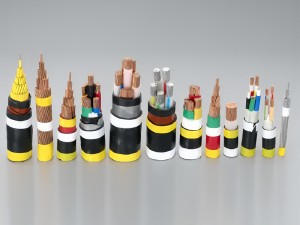The structure of the cable seems simple, in fact, each component of it has its own important purpose, so each component material must be carefully selected when manufacturing the cable, so as to ensure the reliability of the cable made of these materials during operation.
1. Conductor material
Historically, the materials used for power cable conductors were copper and aluminum. Sodium was also briefly tried. Copper and aluminum have better electrical conductivity, and the amount of copper is relatively less when transmitting the same current, so the outer diameter of the copper conductor is smaller than that of the aluminum conductor. The price of aluminum is significantly lower than copper. In addition, because the density of copper is larger than that of aluminum, even if the current carrying capacity is the same, the cross section of aluminum conductor is larger than that of copper conductor, but aluminum conductor cable is still lighter than copper conductor cable.
2. Insulation materials
There are many insulating materials that MV power cables can use, even including technologically mature impregnated paper insulation materials, which have been successfully used for more than 100 years. Today, extruded polymer insulation has been widely accepted. Extruded polymer insulation materials include PE(LDPE and HDPE), XLPE, WTR-XLPE and EPR. These materials are thermoplastic as well as thermosetting. Thermoplastic materials deform when heated, while thermoset materials retain their shape at operating temperatures.
2.1. Paper insulation
At the beginning of their operation, paper-insulated cables carry only a small load and are relatively well maintained. However, power users continue to make the cable carrying more and more high load, the original conditions of use are no longer suitable for the needs of the current cable, then the original good experience can not represent the future operation of the cable must be good. In recent years, paper insulated cables have been rarely used.
2.2. PVC
PVC is still used as an insulating material for low-voltage 1kV cables and is also a sheathing material. However, the application of PVC in cable insulation is rapidly being replaced by XLPE, and the application in sheath is rapidly being replaced by linear low density polyethylene (LLDPE), medium density polyethylene (MDPE) or high density polyethylene (HDPE), and non-PVC cables have lower life cycle costs.
2.3. Polyethylene (PE)
Low density polyethylene (LDPE) was developed in the 1930s and is now used as a base resin for crosslinked polyethylene (XLPE) and water-resistant tree crosslinked polyethylene (WTR-XLPE) materials. In the thermoplastic state, the maximum operating temperature of polyethylene is 75 ° C, which is lower than the operating temperature of paper insulated cables (80~90 ° C). This problem has been solved with the advent of cross-linked polyethylene (XLPE), which can meet or exceed the service temperature of paper-insulated cables.
2.4. Cross-linked polyethylene (XLPE)
XLPE is a thermosetting material made by mixing low-density polyethylene (LDPE) with a crosslinking agent (such as peroxide).
The maximum conductor operating temperature of the XLPE insulated cable is 90 ° C, the overload test is up to 140 ° C, and the short-circuit temperature can reach 250 ° C. XLPE has excellent dielectric characteristics and can be used in the voltage range of 600V to 500kV.
2.5. Water resistant tree Cross-linked polyethylene (WTR-XLPE)
Water tree phenomenon will reduce the service life of XLPE cable. There are many ways to reduce water tree growth, but one of the most commonly accepted is to use specially engineered insulation materials designed to inhibit water tree growth, called water-resistant tree cross-linked polyethylene WTR-XLPE.
2.6. Ethylene propylene rubber (EPR)
EPR is a thermosetting material made of ethylene, propylene (sometimes a third monomer), and the copolymer of the three monomers is called ethylene propylene diene rubber (EPDM). Over a wide temperature range, EPR always remains soft and has good corona resistance. However, the dielectric loss of EPR material is significantly higher than that of XLPE and WTR-XLPE.
3. Insulation vulcanization process
The crosslinking process is specific to the polymer used. The manufacture of crosslinked polymers starts with a matrix polymer and then stabilizers and crosslinkers are added to form a mixture. The crosslinking process adds more connection points to the molecular structure. Once cross-linked, the polymer molecular chain remains elastic, but cannot be completely severed into a fluid melt.
4. Conductor shielding and insulating shielding materials
The semi-conductive shielding layer is extruded on the outer surface of the conductor and insulation to uniform the electric field and to contain the electric field in the cable insulated core. This material contains an engineering grade of carbon black material to enable the shielding layer of the cable to achieve a stable conductivity within the required range.
Post time: Apr-12-2024


